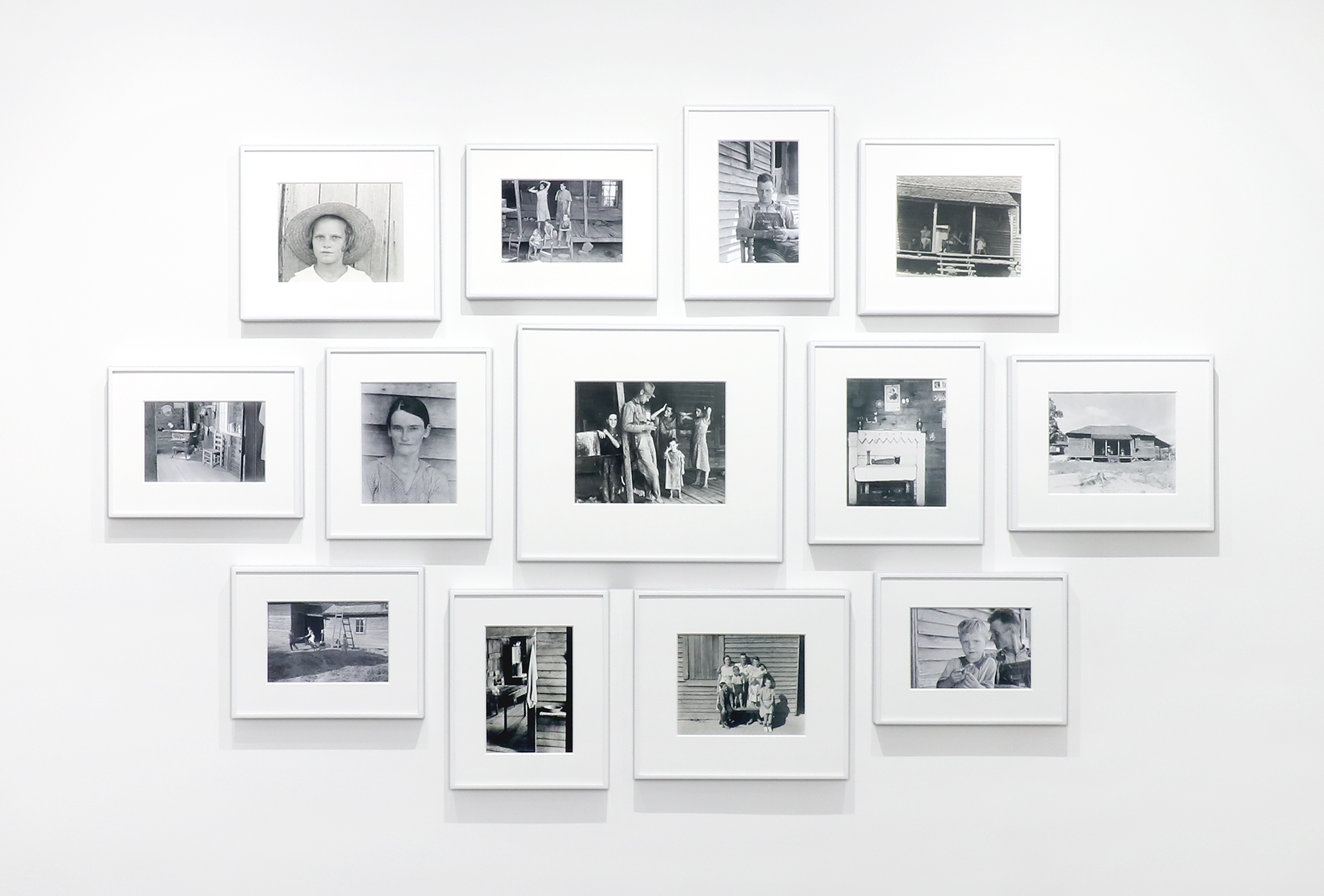
The current exhibition, “Sherrie Levine, Walker Evans, the Library of Congress, and others: The Burroughs Family (a collection)” took 88 years to come together. Below is a recounting of how and why it was assembled:
In June of 1936, Walker Evans traveled to Alabama with writer James Agee on an assignment for Fortune magazine to produce a new installment in a series of articles on the Depression and its effect on what the magazine considered “average” Americans and specifically for this assignment, sharecroppers. To do this, Evans took a leave from the Resettlement Administration (which was soon succeeded by the Farm Services Administration) where he was working, with the agreement that the negatives would become property of the US Government. While Fortune declined to print their article, Agee and Evans continued the project, ultimately publishing the book, Let Us Now Praise Famous Men, in which Evans’s photographs prefaced Agee’s text.
In Alabama, over eight weeks, Agee and Evans had become familiar with three families of farmers in Hale County: the Fields, the Tingles, and the Burroughs. The writer and the photographer embedded themselves in the lives of these families, sharing their day-to-day experiences. Evans made photographs of the families, their homes, and their ways of life. In Let Us Now Praise Famous Men, Agee notes that the Burroughs’ home, despite appearances, was only eight years old when the pictures were made. In addition to farmland and housing, Floyd Burroughs also leased farm equipment and, as payment, surrendered half his harvest to his landlord. He regularly ended the year in debt. Evans’ photographs neither romanticized nor criticized their subjects, they presented them.
In 1981, 45 years after Evans photographed these families, Sherrie Levine re-photographed reproductions of Evans’ work straight out of a book for a project she titled “After Walker Evans.” Evans was one of several male “artist hero” of classical Modernism that Levine had chosen to reproduce work by as a way of questioning traditional notions of the male artist as authority and/or genius. Levine’s use of the prefix “After” in her title acknowledged the chronological precedent of Evans while also referring to the widely accepted practice in the history of art of making copies “after” established masterpieces. By claiming these existing photographs as her own, as well as titling them as she did, Levine asked questions about authenticity, ownership, and originality, as well as how these aspects have traditionally been the basis for valuing works of art. Levine has stated, “The pictures I make are really ghosts of ghosts: their relationship to the original images is tertiary, i.e., three or four times removed.”
The use of the word, “ghost” by Levine makes sense for her own work and it also resonates for Evans’ approach and the “lives” of the negatives from the Let Us Now Praise Famous Men series as, over the course of Evans’ life, the negatives had been used to make prints by Evans and by his associates, as well as by the Library of Congress itself (the Federal organization that manages the FSA holdings and owns the negatives). The definitions of the words “authentic,” “original,” and “vintage” are murky when it comes to these works.
Similarly, over the years, Levine had re-printed some of the images from “After Walker Evans” in various sizes (from approximately 3 x 5 inches to 9 x 13 inches). At larger sizes, one sees the quality of the reproduction being captured as much as the image of the Burroughs family, themselves. The 1981 prints were praised as a feminist hijacking of patriarchal authority and a critique of the commodification of art. Little comment has been made, specifically, about the various prints Levine has made since 1981.
With this sort of grey-zone being seemingly significant for Levine’s practice and also for the lives of Evans’ works, a presentation fully engaging the “ghosts” seems an appropriate way to present both artists’ works together. Central in the presentation is Evans’ own print, “Burroughs Family, Hale County, Alabama,” (the image of the entire family, standing against an exterior wall of the family home). Above that is Levine’s “After Walker Evans: 1,” (the image of most of Floyd Burroughs and his neighbor’s children standing against/near a porch post). Surrounding these two “original” photographs are other photos, all different images of the Burroughs, all from Evans’ negatives. The exhibition, as a whole, has vintage prints by Evans and by associates, and vintage prints by the anonymous printers at the Library of Congress. Also on exhibition are a number of 2024 digital prints that come directly from scans of the original negatives and were recently printed by the Library of Congress.
Furthermore, also included in the exhibition is the original 1941 book, Let Us Now Praise Famous Men. It first came to publication with 30 images by Evans in 1941 and was met with little acclaim. It was reissued in 1960 (now with 61 images) and has since become a “classic” of American literature. Since that time, the book has been reprinted numerous times (with selective editing and re-sizing of the various images). Nine versions of the book are on display and available for perusing.
As a whole, the exhibition hopes to honor both Levine and Evans, as well as the numerous other people who have played significant roles in these projects (Agee, the Burroughs, Library of Congress, and many others), and also attempts to bring forth the problematics of both artists’ practices so that they can be appreciated.
(The group of books and photographs are being kept together and sold as one collection.)
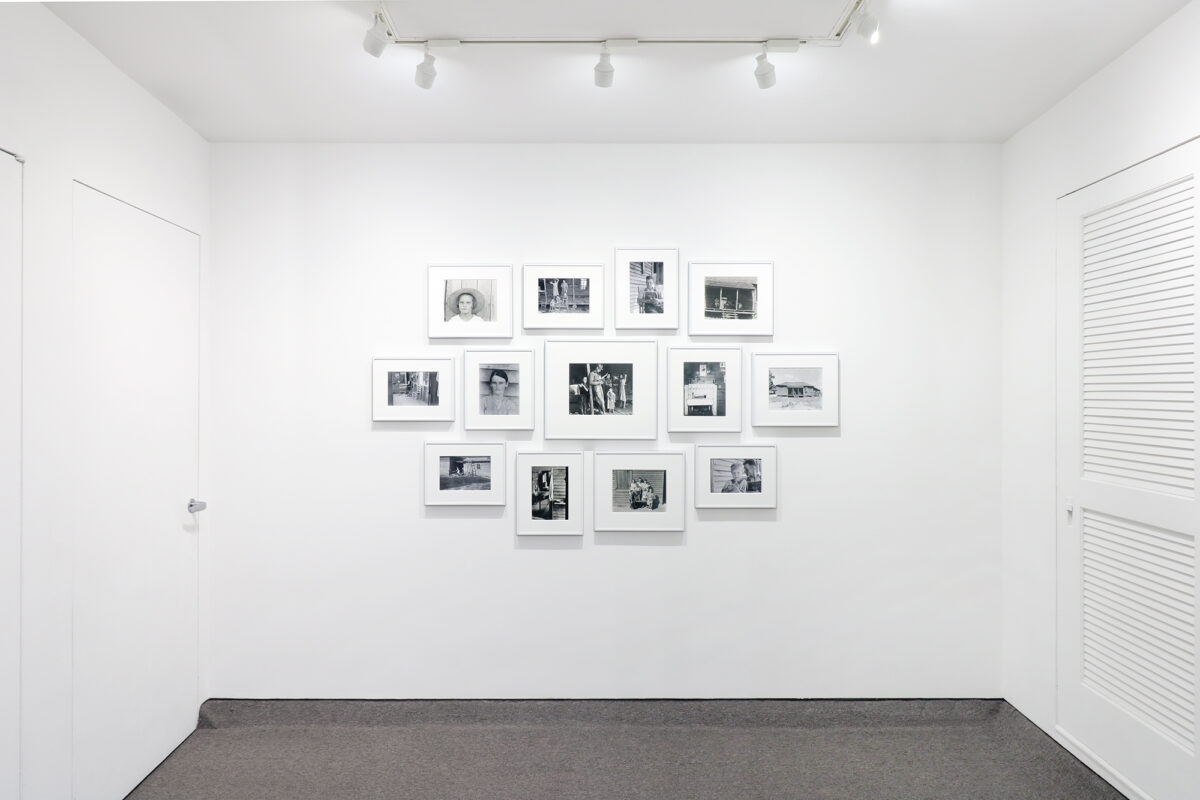
1936, printed ca. 1970 by Library of Congress from the original negative
Image size: 7 3/8 x 9 1/4 inches (18.7 x 23.5 cm)
Paper size: 8 x 10 inches (20.3 x 25.4 cm)
Frame size: 12 1/2 x 14 1/2 inches (31.8 x 36.8 cm)
Verso: stamped in ink, “PHOTODUPLICATION SERVICE,” written in graphite, “LC-USF342-TO1-008140,” and “Walker Evans 1936”
History:
Stamped with Library of Congress Photoduplication Service stamp, verso, most likely circa 1970
(Inventory #36313)
1936, printed ca. 1970 by Library of Congress from the original negative
Image size: 7 3/8 x 9 1/4 inches (18.7 x 23.5 cm)
Paper size: 8 x 10 inches (20.3 x 25.4 cm)
Frame size: 12 1/2 x 14 1/2 inches (31.8 x 36.8 cm)
Verso: stamped in ink, “PHOTODUPLICATION SERVICE,” written in graphite, “LC-USF342-TO1-008140,” and “Walker Evans 1936”
History:
Stamped with Library of Congress Photoduplication Service stamp, verso, most likely circa 1970
(Inventory #36313)
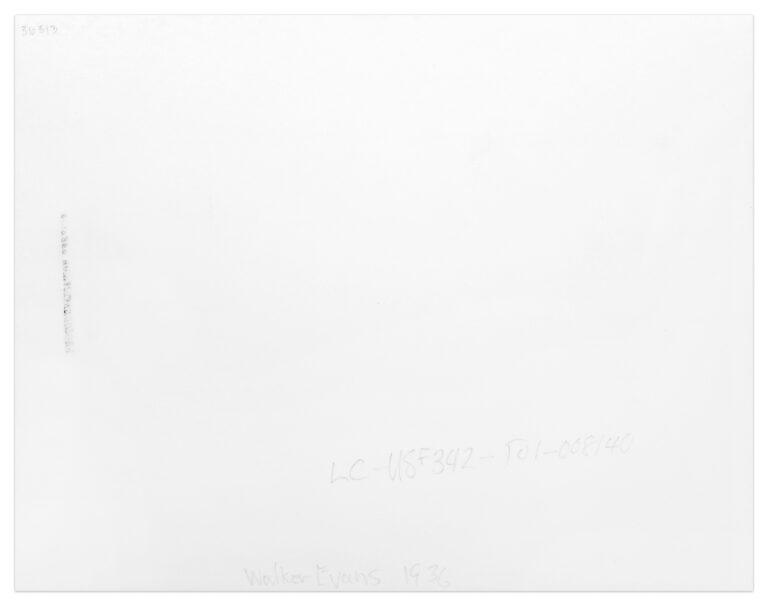
1936, printed 2024 by Library of Congress from a scan of the original negative
Image size: 6 1/8 x 9 inches (15.6 x 22.9 cm)
Paper size: 8 x 10 inches (20.3 x 25.4 cm)
Frame size: 11 x 13 7/8 inches (27.9 x 35.2 cm)
Verso: nothing written
History:
Ordered from the Library of Congress in 2024
(Inventory #36385)
1936, printed 2024 by Library of Congress from a scan of the original negative
Image size: 6 1/8 x 9 inches (15.6 x 22.9 cm)
Paper size: 8 x 10 inches (20.3 x 25.4 cm)
Frame size: 11 x 13 7/8 inches (27.9 x 35.2 cm)
Verso: nothing written
History:
Ordered from the Library of Congress in 2024
(Inventory #36385)
1936, printed 2024 by Library of Congress from a scan of the original negative
Image size: 9 x 6 inches (22.9 x 15.2 cm)
Paper size: 10 x 8 inches (25.4 x 20.3 cm)
Frame size: 13 7/8 x 10 7/8 inches (35.2 x 27.6 cm)
Verso: nothing written
History:
Ordered from the Library of Congress in 2024
(Inventory #36386)
1936, printed 2024 by Library of Congress from a scan of the original negative
Image size: 9 x 6 inches (22.9 x 15.2 cm)
Paper size: 10 x 8 inches (25.4 x 20.3 cm)
Frame size: 13 7/8 x 10 7/8 inches (35.2 x 27.6 cm)
Verso: nothing written
History:
Ordered from the Library of Congress in 2024
(Inventory #36386)
1936, printed ca. 1940 by an unknown hand
Image size/paper size: 7 5/8 x 9 3/8 inches (19.4 x 23.8 cm)
Frame size: 12 1/2 x 14 3/8 inches (31.8 x 36.5 cm)
Verso: nothing written
Provenance:
Photo West Gallery, San Diego, California
Private Collection
Swann Galleries
(Inventory #36067)
1936, printed ca. 1940 by an unknown hand
Image size/paper size: 7 5/8 x 9 3/8 inches (19.4 x 23.8 cm)
Frame size: 12 1/2 x 14 3/8 inches (31.8 x 36.5 cm)
Verso: nothing written
Provenance:
Photo West Gallery, San Diego, California
Private Collection
Swann Galleries
(Inventory #36067)
1936, printed 2024 by Library of Congress from a scan of the original negative
Image size: 6 x 9 inches (15.2 x 22.9 cm)
Paper size: 8 x 10 inches (20.3 x 25.4 cm)
Frame size: 10 7/8 x 13 7/8 inches (27.6 x 35.2 cm)
Verso: nothing written
History:
Ordered from the Library of Congress in 2024
(Inventory #36382)
1936, printed 2024 by Library of Congress from a scan of the original negative
Image size: 6 x 9 inches (15.2 x 22.9 cm)
Paper size: 8 x 10 inches (20.3 x 25.4 cm)
Frame size: 10 7/8 x 13 7/8 inches (27.6 x 35.2 cm)
Verso: nothing written
History:
Ordered from the Library of Congress in 2024
(Inventory #36382)
1936, printed 2024 by Library of Congress from a scan of the original negative
Image size: 9 x 7 inches (22.9 x 17.8 cm)
Paper size: 10 x 8 inches (25.4 x 20.3 cm)
Frame size: 13 3/4 x 12 inches (34.9 x 30.5 cm)
Verso: nothing written
History:
Ordered from the Library of Congress in 2024
(Inventory #36387)
1936, printed 2024 by Library of Congress from a scan of the original negative
Image size: 9 x 7 inches (22.9 x 17.8 cm)
Paper size: 10 x 8 inches (25.4 x 20.3 cm)
Frame size: 13 3/4 x 12 inches (34.9 x 30.5 cm)
Verso: nothing written
History:
Ordered from the Library of Congress in 2024
(Inventory #36387)
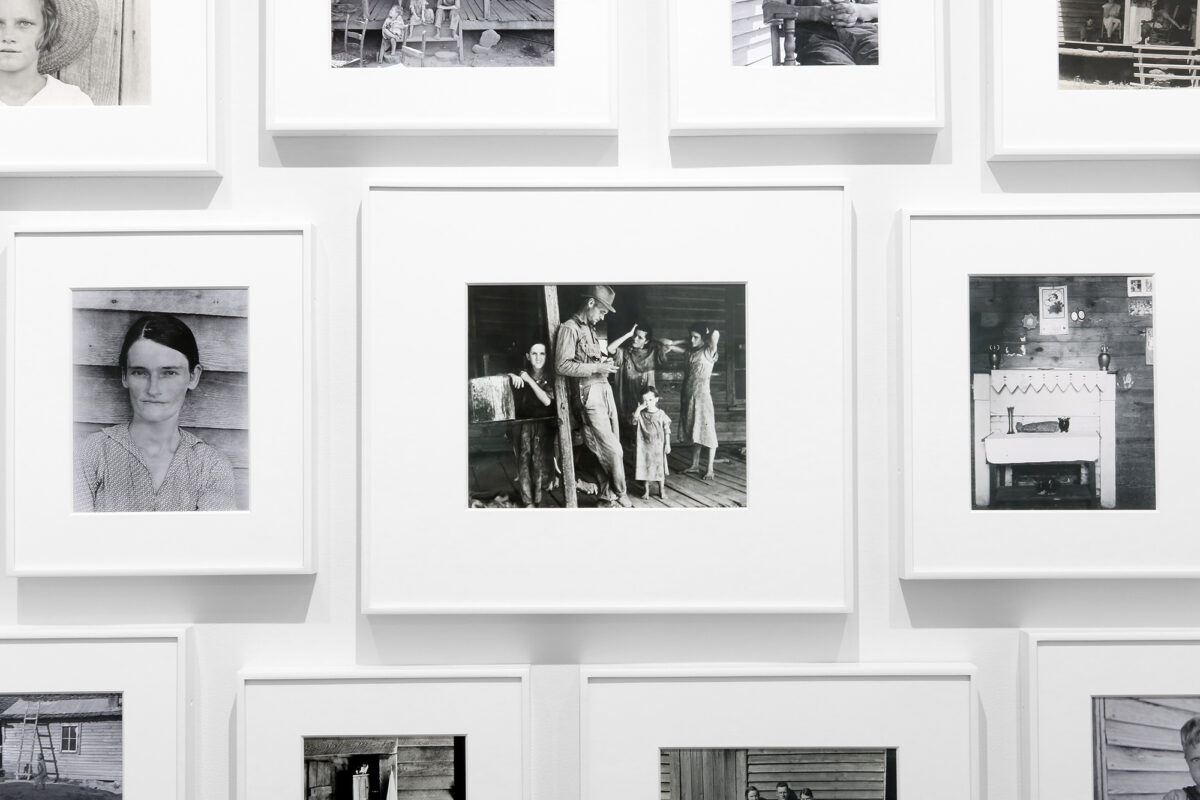
Image size: 9 x 13 1/2 inches (22.9 x 34.3 cm)
Paper size: 16 5/8 x 20 1/2 inches (42.2 x 52.1 cm)
Frame size: 17 1/4 x 19 1/4 inches (43.8 x 48.9 cm)
Verso: stamped in ink, “11,” and “2,” and written in graphite, “2”
(Inventory #36587)
Provenance:
Mary Boone Gallery, New York
Monika Sprüth Galerie, Cologne
Sotheby’s, London
The Collection of Chara Schreyer
Sotheby’s, New York
History:
Negative is from 1981, this print is from 1990
Reproduced:
Alisa Carroll, Art House: The Collaboration of Chara Schreyer & Gary Hutton, New York 2016, pp. 114, 221, illustrated
Douglas Fogle and Hanneke Skerath, eds., Making Strange: The Chara Schreyer Collection, New York 2021, pp. 213 and 416, illustrated
Johanna Burton and Elisabeth Sussman, Sherrie Levine: Mayhem, New York: Whitney Museum of American Art 2011, p. 44
Sherrie Levine, New York and London 2007, p. 4, illustrated
Image size: 9 x 13 1/2 inches (22.9 x 34.3 cm)
Paper size: 16 5/8 x 20 1/2 inches (42.2 x 52.1 cm)
Frame size: 17 1/4 x 19 1/4 inches (43.8 x 48.9 cm)
Verso: stamped in ink, “11,” and “2,” and written in graphite, “2”
(Inventory #36587)
Provenance:
Mary Boone Gallery, New York
Monika Sprüth Galerie, Cologne
Sotheby’s, London
The Collection of Chara Schreyer
Sotheby’s, New York
History:
Negative is from 1981, this print is from 1990
Reproduced:
Alisa Carroll, Art House: The Collaboration of Chara Schreyer & Gary Hutton, New York 2016, pp. 114, 221, illustrated
Douglas Fogle and Hanneke Skerath, eds., Making Strange: The Chara Schreyer Collection, New York 2021, pp. 213 and 416, illustrated
Johanna Burton and Elisabeth Sussman, Sherrie Levine: Mayhem, New York: Whitney Museum of American Art 2011, p. 44
Sherrie Levine, New York and London 2007, p. 4, illustrated
1936, printed ca. 1950 by Jack Welpott from the original negative
Image size: 9 5/8 x 7 5/8 inches (24.4 x 19.4 cm)
Paper size: 10 x 8 inches (25.4 x 20.3 cm)
Frame size: 14 x 12 5/8 inches (35.6 x 32.1 cm)
Verso: written in graphite, “Walker Evans – 1936,” “25,” “#1 paper,” and “1-2”
Provenance:
Jack Welpott
Gift to Jan Welpott Danielle
History:
While studying photography with Henry Holmes Smith at Indiana University, Jack Welpott printed this photograph from the original Walker Evans negatives, which were on loan to Smith from the FSA Collection (housed in the Library of Congress, D.C.).
(Inventory #36379)
1936, printed ca. 1950 by Jack Welpott from the original negative
Image size: 9 5/8 x 7 5/8 inches (24.4 x 19.4 cm)
Paper size: 10 x 8 inches (25.4 x 20.3 cm)
Frame size: 14 x 12 5/8 inches (35.6 x 32.1 cm)
Verso: written in graphite, “Walker Evans – 1936,” “25,” “#1 paper,” and “1-2”
Provenance:
Jack Welpott
Gift to Jan Welpott Danielle
History:
While studying photography with Henry Holmes Smith at Indiana University, Jack Welpott printed this photograph from the original Walker Evans negatives, which were on loan to Smith from the FSA Collection (housed in the Library of Congress, D.C.).
(Inventory #36379)
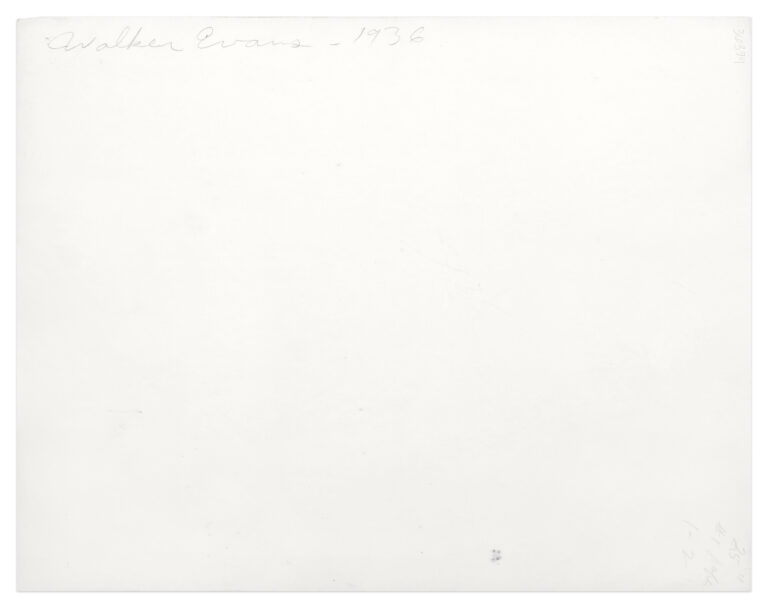
1936, printed ca. 1950 by Jack Welpott from the original negative
Image size: 7 5/8 x 9 5/8 inches (19.4 x 24.4 cm)
Paper size: 8 x 10 inches (20.3 x 25.4 cm)
Frame size: 12 5/8 x 14 5/8 inches (32.1 x 37.1 cm)
Verso: written in graphite, “Walker Evans – 1936,” “4,”” “1-2,” and “70””
Provenance:
Jack Welpott
Gift to Jan Welpott Danielle
History:
While studying photography with Henry Holmes Smith at Indiana University, Jack Welpott printed this photograph from the original Walker Evans negatives, which were on loan to Smith from the FSA Collection (housed in the Library of Congress, D.C.).
(Inventory #36378)
1936, printed ca. 1950 by Jack Welpott from the original negative
Image size: 7 5/8 x 9 5/8 inches (19.4 x 24.4 cm)
Paper size: 8 x 10 inches (20.3 x 25.4 cm)
Frame size: 12 5/8 x 14 5/8 inches (32.1 x 37.1 cm)
Verso: written in graphite, “Walker Evans – 1936,” “4,”” “1-2,” and “70””
Provenance:
Jack Welpott
Gift to Jan Welpott Danielle
History:
While studying photography with Henry Holmes Smith at Indiana University, Jack Welpott printed this photograph from the original Walker Evans negatives, which were on loan to Smith from the FSA Collection (housed in the Library of Congress, D.C.).
(Inventory #36378)
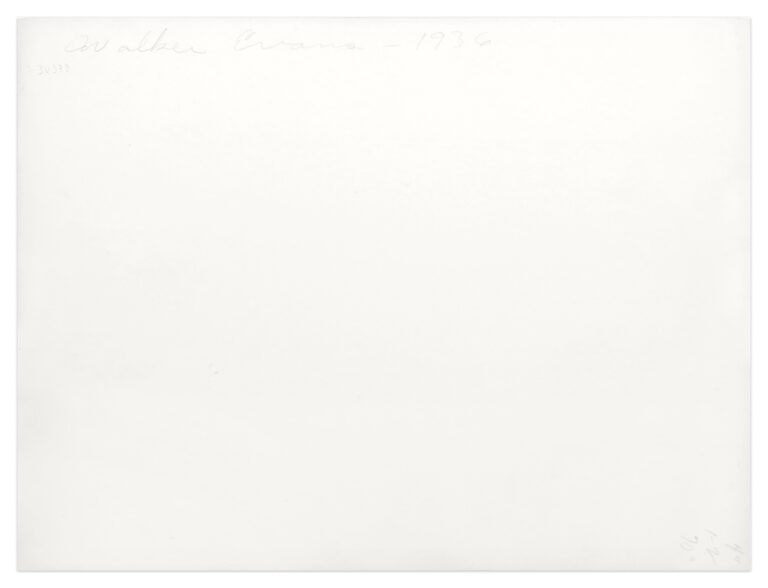
1936, printed 2024 by Library of Congress from a scan of the original negative
Image size: 6 x 9 inches (15.2 x 22.9 cm)
Paper size: 8 x 10 inches (20.3 x 25.4 cm)
Frame size: 10 7/8 x 13 7/8 inches (27.6 x 35.2 cm)
Verso: nothing written
History:
Ordered from the Library of Congress in 2024
(Inventory #36383)
1936, printed 2024 by Library of Congress from a scan of the original negative
Image size: 6 x 9 inches (15.2 x 22.9 cm)
Paper size: 8 x 10 inches (20.3 x 25.4 cm)
Frame size: 10 7/8 x 13 7/8 inches (27.6 x 35.2 cm)
Verso: nothing written
History:
Ordered from the Library of Congress in 2024
(Inventory #36383)
1936, printed ca. 1970 by Library of Congress from the original negative
Image size: 9 7/16 x 6 9/16 inches (24 x 16.7 cm)
Paper size: 10 x 8 inches (25.4 x 20.3 cm)
Frame size: 14 1/4 x 11 1/2 inches (36.2 x 29.2 cm)
Verso: stamped in ink, “PHOTODUPLICATION SERVICE,” written in graphite, “LC-USF342-008133,” and “Walker Evans 1936”
History:
Stamped with Library of Congress Photoduplication Service stamp, verso, most likely circa 1970
(Inventory #36314)
1936, printed ca. 1970 by Library of Congress from the original negative
Image size: 9 7/16 x 6 9/16 inches (24 x 16.7 cm)
Paper size: 10 x 8 inches (25.4 x 20.3 cm)
Frame size: 14 1/4 x 11 1/2 inches (36.2 x 29.2 cm)
Verso: stamped in ink, “PHOTODUPLICATION SERVICE,” written in graphite, “LC-USF342-008133,” and “Walker Evans 1936”
History:
Stamped with Library of Congress Photoduplication Service stamp, verso, most likely circa 1970
(Inventory #36314)
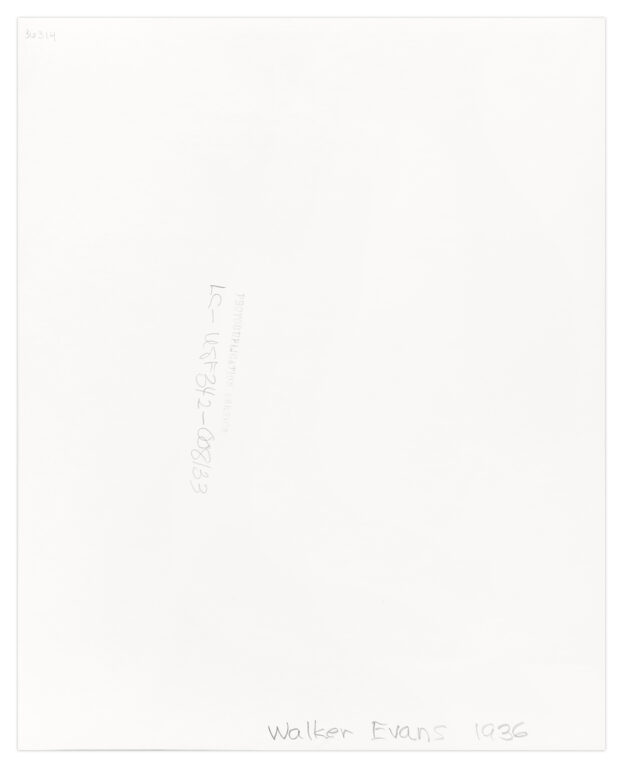
1936, printed later by an unknown hand
Image size: 7 3/8 x 9 3/8 inches (18.7 x 23.8 cm)
Paper size: 11 7/8 x 11 3/8 inches (30.2 x 28.9 cm)
Frame size: 13 1/2 x 15 1/2 inches (34.3 x 39.4 cm)
Verso: nothing written
Provenance:
Estate of Walker Evans, New Haven
Frances Lindley, New York
Robert Klein Gallery, Boston
(Inventory #36642)
1936, printed later by an unknown hand
Image size: 7 3/8 x 9 3/8 inches (18.7 x 23.8 cm)
Paper size: 11 7/8 x 11 3/8 inches (30.2 x 28.9 cm)
Frame size: 13 1/2 x 15 1/2 inches (34.3 x 39.4 cm)
Verso: nothing written
Provenance:
Estate of Walker Evans, New Haven
Frances Lindley, New York
Robert Klein Gallery, Boston
(Inventory #36642)
1936, printed 2024 by Library of Congress from a scan of the original negative
Image size: 6 x 9 inches (15.2 x 22.9 cm)
Paper size: 8 x 10 inches (20.3 x 25.4 cm)
Frame size: 10 7/8 x 13 7/8 inches (27.6 x 35.2 cm)
Verso: nothing written
History:
Ordered from the Library of Congress in 2024
(Inventory #36388)
1936, printed 2024 by Library of Congress from a scan of the original negative
Image size: 6 x 9 inches (15.2 x 22.9 cm)
Paper size: 8 x 10 inches (20.3 x 25.4 cm)
Frame size: 10 7/8 x 13 7/8 inches (27.6 x 35.2 cm)
Verso: nothing written
History:
Ordered from the Library of Congress in 2024
(Inventory #36388)
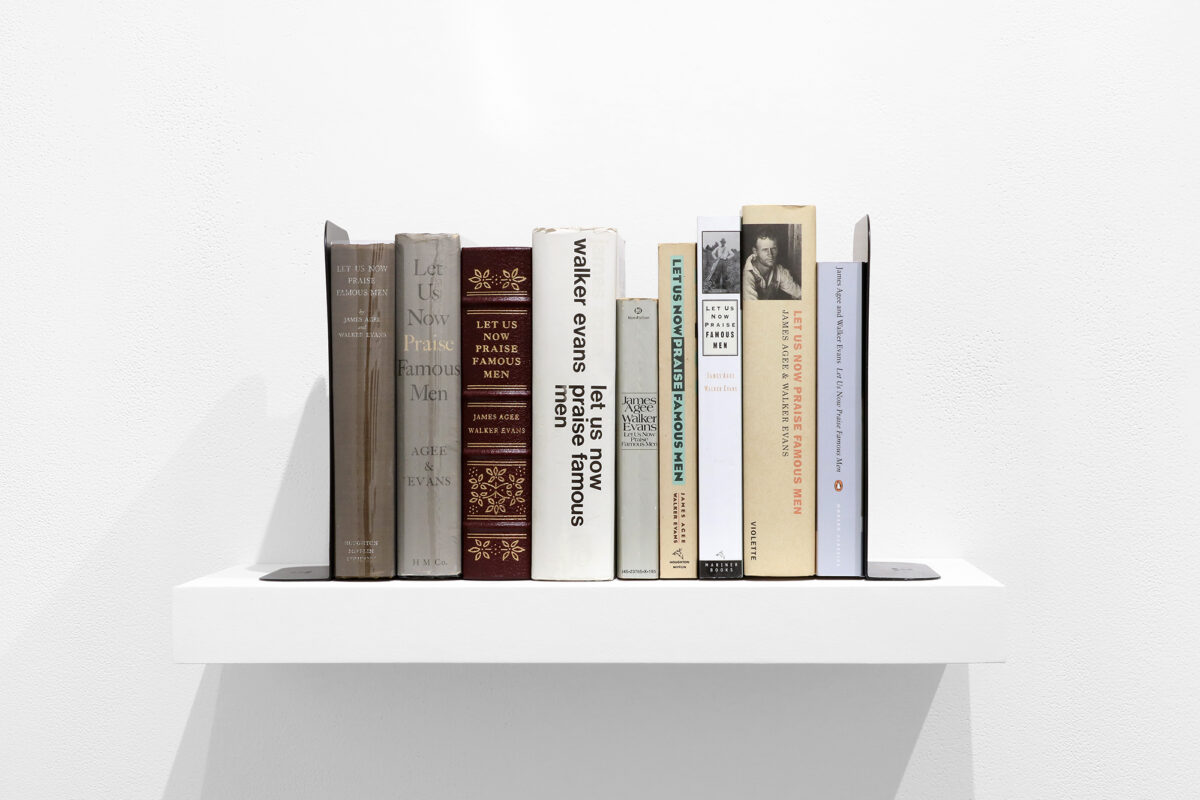
Editions of Let Us Now Praise Famous Men from 1941 to 2008
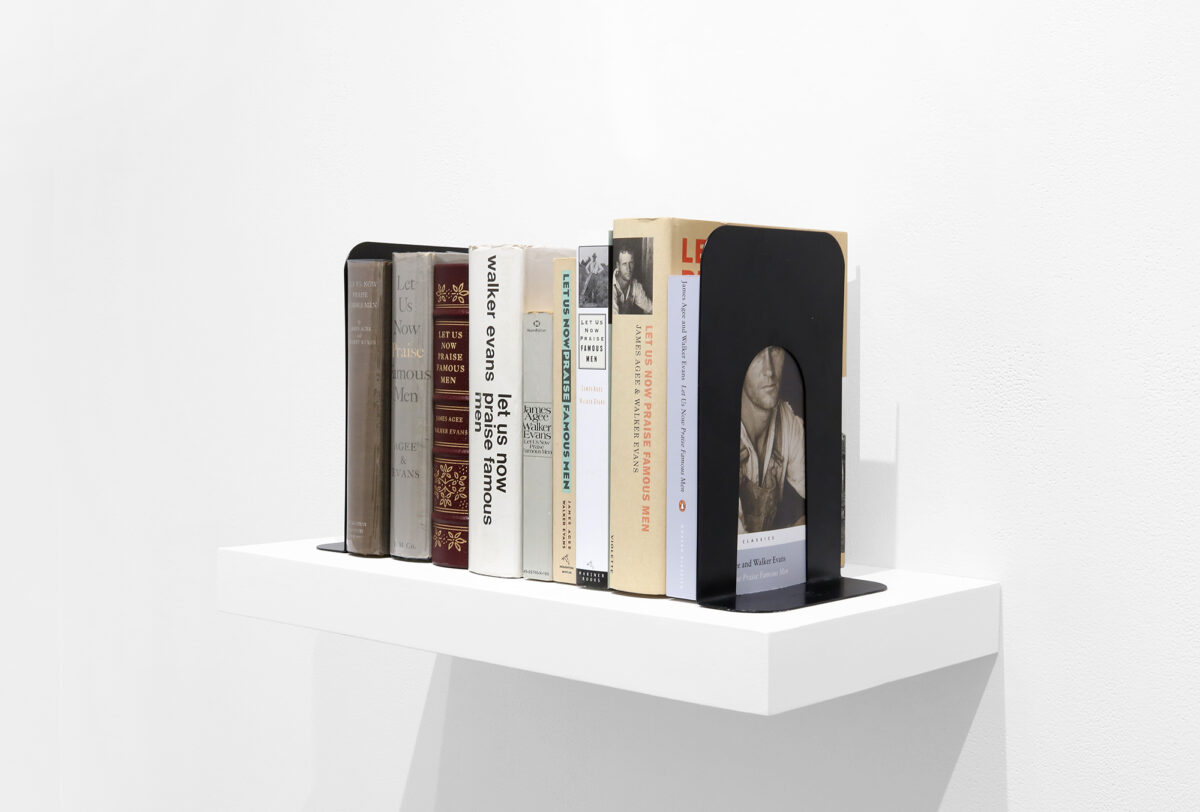
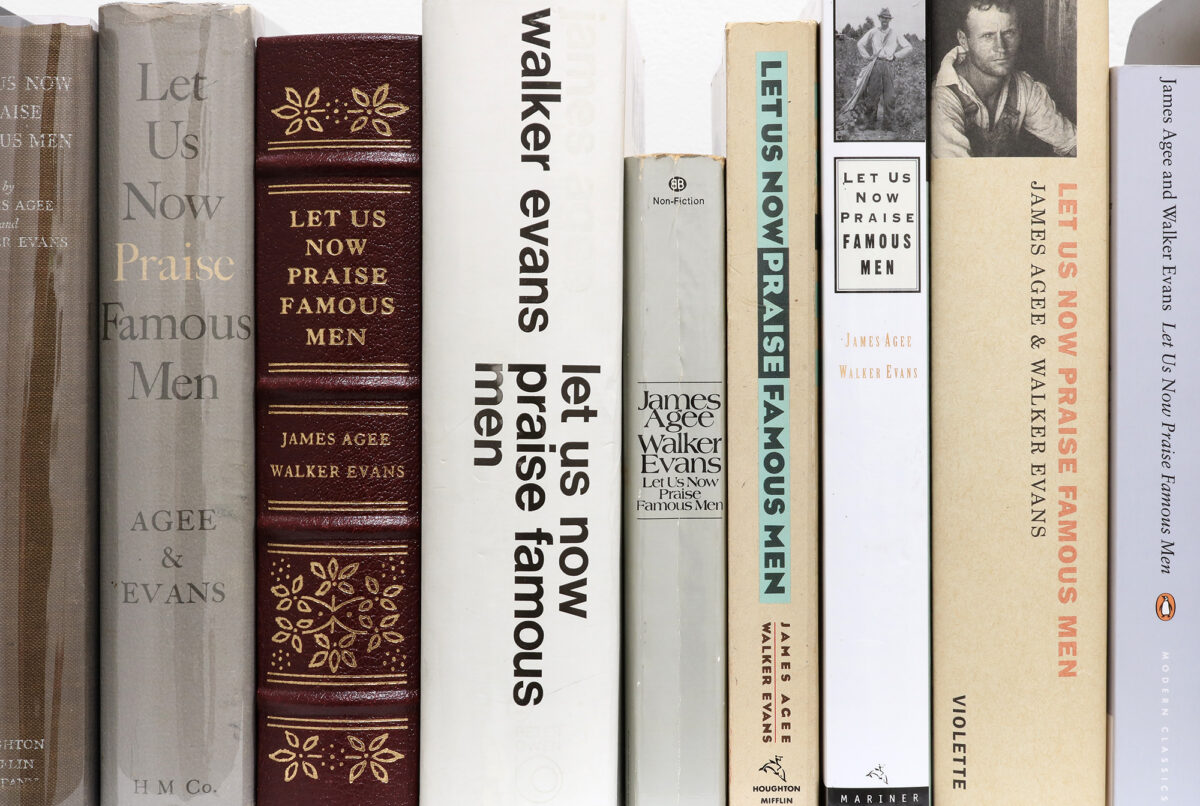
No results found.
10 Newbury Street, Boston, Massachusetts 02116
617-262-4490 | info@krakowwitkingallery.com
The gallery is free and open to the public Tuesday – Saturday, 10am – 5:30pm